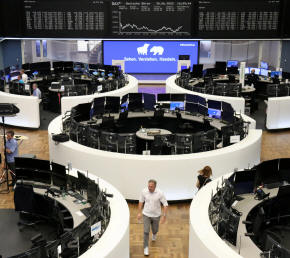Second half starts with fresh swings for stocks
 Send a link to a friend
Send a link to a friend
 [July 01, 2022] By
Marc Jones [July 01, 2022] By
Marc Jones
LONDON (Reuters) - The second half of the
year started with more volatility for global stocks on Friday, as
recession concerns that have built in recent weeks also pulled metals
and commodity currencies lower again.
MSCI's world stocks index has had its worst start to a year since its
1990 creation over the last six months, and an early tumble followed by
recovery by both Europe and Wall Street futures pointed to more
instability ahead. [.EU][.N]
Asia had thudded lower, too, with the heaviest fall in Taiwan, where the
growth-sensitive benchmark index slid more than 3% to its lowest since
late 2020.
Japan's Nikkei fell 1.75%. The Australian and New Zealand dollars each
fell 1% to two-year lows.
Growth-sensitive copper was down 2.7% and heading for its forth straight
weekly drop, while U.S. Treasuries and German Bunds rallied in the bond
markets.. [.T] [US/] [EUR/GVD]
Natixis' Head of European Macro Research Dirk Schumacher said that while
the region was not in recession yet, the worry was that it could get
pushed into one.
Data on Friday showed manufacturing production in the euro zone fell for
the first time last month since the initial wave of the coronavirus
pandemic in 2020, while inflation numbers hit another record high.

"In Europe, and globally, the cyclical picture is not looking great,"
Schumacher said. "There is a long list of risk factors," he added, and
"the usual safety valve (of lower interest rates or central bank
stimulus) is obviously not there now."
Across the Atlantic, the S&P 500 futures were pointing fractionally
lower again after the benchmark U.S. index had closed out its worst
first-half since 1970 on Thursday. [.N]
The Fed's rapid rise in interest rates mean the Treasury market took
such a beating that Deutsche Bank estimated the half's performance was
the poorest since 1788 - the year the U.S. constitution was ratified .
It has been hints of peaking inflation and signs of weak growth that
have started steadying bond markets, though.
Two-year Treasuries are on course for their best week since markets'
pandemic meltdown of March 2020 as traders now wind back rate hike bets.
Moves were turning choppy again on Friday. But the two-year U.S. yield
is down almost 14 basis points (bps) this week to 2.91%. The 10-year
yield is down about 15 bps on the week to 2.99% and Bund yields have
dropped to 1.39% from a high of 1.56% on Monday.
[to top of second column] |

The German share price index DAX graph is pictured at the stock
exchange in Frankfurt, Germany, June 30, 2022. REUTERS/Staff

Fed funds futures [FEDWATCH], which a few weeks ago were priced for rates to hit
4% next year, are now showing that markets expect rate cuts by the middle of
2023 and a peak below 3.5%.
CHINA BRIGHT
The dollar was on the front foot again on Friday, having just scored its best
quarter since 2016 as U.S. yields rose. Its reputation means economic
uncertainty has kept it supported even as yields have retreated.
"It's safe-haven demand," said Khoon Goh, head of Asia research at ANZ Bank in
Singapore.
Other safe-haven currencies such as the Japanese yen and the Swiss franc also
drew investors. The yen rose about 0.2% to 135.40 per dollar and a little
further to 141.64 per euro.
But the Australian dollar fell through support at $0.6850 in Asia and was last
down 1.4% at $0.6803. The kiwi slid 1.1% to 0.6178. [AUD/]
A string of business surveys on Friday showed China emerging as an outlier as
its economy slowly recovers from COVID-19 lockdowns. Factory activity bounced
solidly in June against slowdowns in Japan and South Korea and a contraction in
Taiwan.
Markets are also bouncing and though the Shanghai Composite and blue-chip CSI300
edged about 0.3% lower on Friday, they are each set to log five straight weeks
of gains.
Hong Kong's markets were closed for a holiday, and the city was focused on
Chinese President Xi Jinping's visit.
The yuan slipped with the broader market to 6.7136 per dollar. Gold has been
weighed by the stronger dollar and U.S. yields and was flirting with $1,800 an
ounce.

Bitcoin, which suffered its biggest quarterly drop on record over the three
months to the end of June, fell 3% to $19,375 on Friday.
(Additional reporting by Tom Westbrook in Singapore; Editing by Alex Richardson
and Kim Coghill)
[© 2022 Thomson Reuters. All rights
reserved.]This material may not be published,
broadcast, rewritten or redistributed.
Thompson Reuters is solely responsible for this content. |